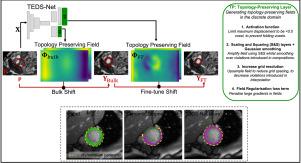当前位置:
X-MOL 学术
›
Med. Image Anal.
›
论文详情
Our official English website, www.x-mol.net, welcomes your
feedback! (Note: you will need to create a separate account there.)
Anatomically plausible segmentations: Explicitly preserving topology through prior deformations
Medical Image Analysis ( IF 10.7 ) Pub Date : 2024-06-15 , DOI: 10.1016/j.media.2024.103222 Madeleine K Wyburd 1 , Nicola K Dinsdale 1 , Mark Jenkinson 2 , Ana I L Namburete 3
Medical Image Analysis ( IF 10.7 ) Pub Date : 2024-06-15 , DOI: 10.1016/j.media.2024.103222 Madeleine K Wyburd 1 , Nicola K Dinsdale 1 , Mark Jenkinson 2 , Ana I L Namburete 3
Affiliation

|
Since the rise of deep learning, new medical segmentation methods have rapidly been proposed with extremely promising results, often reporting marginal improvements on the previous state-of-the-art (SOTA) method. However, on visual inspection errors are often revealed, such as topological mistakes (e.g. holes or folds), that are not detected using traditional evaluation metrics. Incorrect topology can often lead to errors in clinically required downstream image processing tasks. Therefore, there is a need for new methods to focus on ensuring segmentations are topologically correct. In this work, we present TEDS-Net: a segmentation network that preserves anatomical topology whilst maintaining segmentation performance that is competitive with SOTA baselines. Further, we show how current SOTA segmentation methods can introduce problematic topological errors. TEDS-Net achieves anatomically plausible segmentation by using learnt topology-preserving fields to deform a prior. Traditionally, topology-preserving fields are described in the continuous domain and begin to break down when working in the discrete domain. Here, we introduce additional modifications that more strictly enforce topology preservation. We illustrate our method on an open-source medical heart dataset, performing both single and multi-structure segmentation, and show that the generated fields contain no folding voxels, which corresponds to full topology preservation on individual structures whilst vastly outperforming the other baselines on overall scene topology. The code is available at: https://github.com/mwyburd/TEDS-Net .
中文翻译:

解剖学上合理的分割:通过先前的变形显式保留拓扑
自深度学习兴起以来,新的医学分割方法迅速被提出,并取得了非常有希望的结果,通常报告对先前最先进(SOTA)方法的边际改进。然而,目视检查经常会发现错误,例如拓扑错误(例如孔或折叠),而使用传统的评估指标无法检测到这些错误。不正确的拓扑通常会导致临床所需的下游图像处理任务出现错误。因此,需要新的方法来专注于确保分割在拓扑上是正确的。在这项工作中,我们提出了 TEDS-Net:一种分割网络,它保留解剖拓扑,同时保持与 SOTA 基线竞争的分割性能。此外,我们还展示了当前的 SOTA 分割方法如何引入有问题的拓扑错误。 TEDS-Net 通过使用学习到的拓扑保持场来变形先验,从而实现了解剖学上合理的分割。传统上,拓扑保持域是在连续域中描述的,并且在离散域中工作时开始崩溃。在这里,我们引入了额外的修改,以更严格地执行拓扑保留。我们在开源医学心脏数据集上说明了我们的方法,执行单结构和多结构分割,并表明生成的字段不包含折叠体素,这对应于单个结构的完整拓扑保留,同时在总体上远远优于其他基线场景拓扑。该代码位于:https://github.com/mwyburd/TEDS-Net。
更新日期:2024-06-15
中文翻译:

解剖学上合理的分割:通过先前的变形显式保留拓扑
自深度学习兴起以来,新的医学分割方法迅速被提出,并取得了非常有希望的结果,通常报告对先前最先进(SOTA)方法的边际改进。然而,目视检查经常会发现错误,例如拓扑错误(例如孔或折叠),而使用传统的评估指标无法检测到这些错误。不正确的拓扑通常会导致临床所需的下游图像处理任务出现错误。因此,需要新的方法来专注于确保分割在拓扑上是正确的。在这项工作中,我们提出了 TEDS-Net:一种分割网络,它保留解剖拓扑,同时保持与 SOTA 基线竞争的分割性能。此外,我们还展示了当前的 SOTA 分割方法如何引入有问题的拓扑错误。 TEDS-Net 通过使用学习到的拓扑保持场来变形先验,从而实现了解剖学上合理的分割。传统上,拓扑保持域是在连续域中描述的,并且在离散域中工作时开始崩溃。在这里,我们引入了额外的修改,以更严格地执行拓扑保留。我们在开源医学心脏数据集上说明了我们的方法,执行单结构和多结构分割,并表明生成的字段不包含折叠体素,这对应于单个结构的完整拓扑保留,同时在总体上远远优于其他基线场景拓扑。该代码位于:https://github.com/mwyburd/TEDS-Net。











































 京公网安备 11010802027423号
京公网安备 11010802027423号